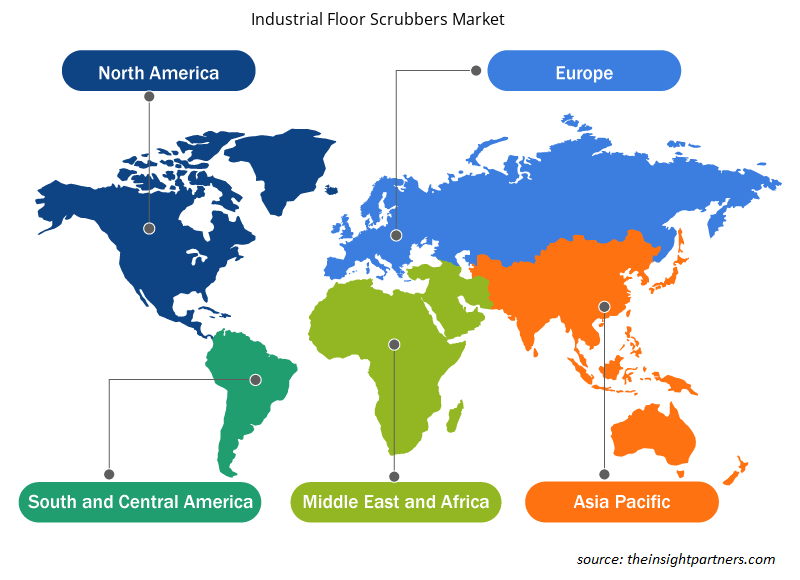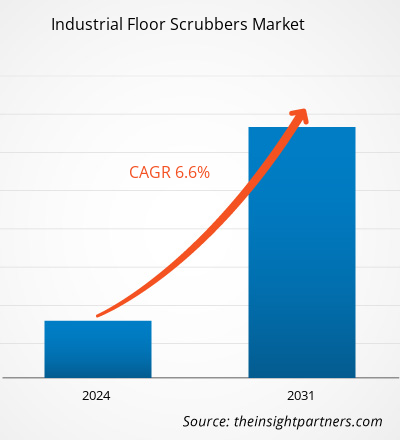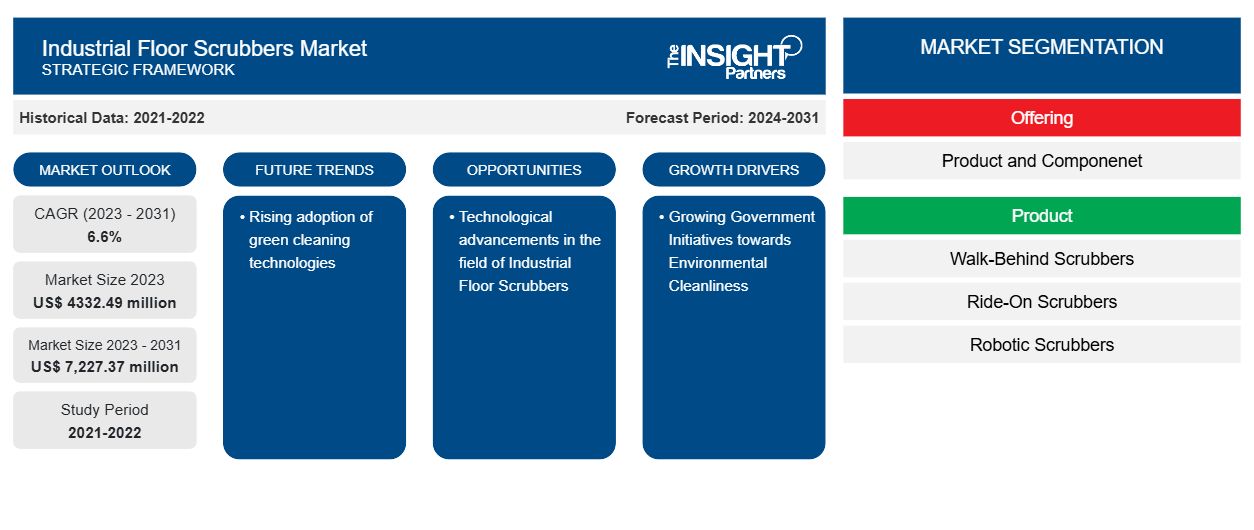Le marché des autolaveuses industrielles devrait atteindre 7 227,37 millions USD d'ici 2031, contre 4 332,49 millions USD en 2023. Le marché devrait enregistrer un TCAC de 6,6 % au cours de la période 2023-2031. L'industrialisation croissante et le nombre croissant d'hôpitaux, d'espaces commerciaux comme les centres commerciaux et les bureaux, ainsi que le nombre croissant de pôles de fabrication devraient rester une tendance clé du marché.
Analyse du marché des autolaveuses industrielles
L'industrialisation croissante et le développement croissant du secteur de la construction devraient accroître le développement des autolaveuses industrielles à l'échelle mondiale. La demande croissante de technologies de nettoyage autonome des sols devrait également stimuler la demande pour le marché mondial des autolaveuses industrielles. La demande croissante d'autolaveuses industrielles dans les hôpitaux, les centres de soins et les espaces commerciaux agit également comme un moteur majeur du marché mondial. Les autolaveuses automatiques sont coûteuses. La mise en œuvre d'autolaveuses automatiques est coûteuse, ce qui pourrait constituer un facteur restrictif pour les autolaveuses industrielles dans les économies en développement. Cependant, les initiatives gouvernementales croissantes pour maintenir la propreté dans les secteurs industriel et commercial devraient orienter le développement du marché mondial des autolaveuses industrielles.
Aperçu du marché des autolaveuses industrielles
L'accent croissant mis par le gouvernement sur la construction de villes intelligentes et le développement d'infrastructures avancées renforcent également le besoin d'équipements de nettoyage pour maintenir la propreté. Les progrès technologiques sur le marché des autolaveuses industrielles pour le nettoyage des sols ont un impact positif sur le marché mondial. Le nombre croissant de points de vente et d'espaces commerciaux tels que les hôtels, les bureaux, les centres commerciaux et les multiplexes alimente également la demande mondiale d'autolaveuses industrielles pour le nettoyage des sols.
Personnalisez ce rapport en fonction de vos besoins
Vous bénéficierez d'une personnalisation gratuite de n'importe quel rapport, y compris de certaines parties de ce rapport, d'une analyse au niveau des pays, d'un pack de données Excel, ainsi que de superbes offres et réductions pour les start-ups et les universités.
-
Obtenez les principales tendances clés du marché de ce rapport.Cet échantillon GRATUIT comprendra une analyse de données, allant des tendances du marché aux estimations et prévisions.
Moteurs et opportunités du marché des autolaveuses industrielles
Les initiatives gouvernementales croissantes en faveur de la propreté environnementale favorisent le marché
Les initiatives gouvernementales croissantes, comme la Swachh Bharat Mission, visant à améliorer l'état des secteurs commercial, industriel et résidentiel en termes de propreté et d'hygiène, constituent un moteur majeur du marché. Divers gouvernements se concentrent sur l'augmentation des services d'entretien des infrastructures publiques telles que les musées, les parcs et les lieux commerciaux, ce qui constitue également un moteur essentiel du marché. Swachh Bharat Mission to improve the condition of commercial, industrial, and residential sectors in terms of cleanliness and hygiene are acting as a major drivers for the market. Various governments are focusing on increasing the maintenance services of public infrastructures like museums, parks, and commercial places which is also acting as a prime driver for the market.
Progrès technologiques dans le domaine des autolaveuses industrielles
Les progrès technologiques croissants en termes d'automatisation des processus et d'intégration de la technologie robotique devraient offrir de grandes opportunités au marché des autolaveuses industrielles. Les entreprises opérant sur le marché des autolaveuses industrielles se concentrent davantage sur les activités de recherche et développement pour introduire des autolaveuses automatiques. En outre, certaines entreprises se concentrent également sur l'introduction de robots dans l' industrie du nettoyage des sols , ce qui devrait également stimuler la croissance du marché mondial des autolaveuses industrielles.
Analyse de segmentation du rapport sur le marché des autolaveuses industrielles
Les segments clés qui ont contribué à l’élaboration de l’analyse du marché des autolaveuses industrielles sont l’offre, le produit, l’utilisation finale et le composant.
- Sur la base de l'offre, le marché des autolaveuses industrielles est divisé en produits et composants. Le segment de produits détenait une part de marché plus importante en 2023.
- Par produit, le marché est segmenté en autolaveuses à conducteur marchant, autolaveuses autoportées et autolaveuses robotisées. Le segment des autolaveuses à conducteur marchant détenait une part importante du marché en 2023.
- En fonction de l'utilisation finale, le marché est segmenté en soins de santé et produits pharmaceutiques, administration publique, hôtellerie, fabrication et entreposage, vente au détail et autres. Le segment de la fabrication et de l'entreposage détenait une part importante du marché en 2023.
- En fonction des composants, le marché des autolaveuses industrielles est divisé en brosses, tampons, raclettes et autres. Les autres segments détenaient une part importante du marché en 2023.
Analyse des parts de marché des autolaveuses industrielles par zone géographique
La portée géographique du rapport sur le marché des autolaveuses industrielles est principalement divisée en cinq régions : Amérique du Nord, Asie-Pacifique, Europe, Moyen-Orient et Afrique, et Amérique du Sud et centrale.
L'Asie-Pacifique est en tête du marché. L'accent croissant mis par le gouvernement sur le maintien de la propreté dans les secteurs commercial et industriel oriente le développement du marché des autolaveuses industrielles en Asie-Pacifique. L'adoption croissante de l'automatisation et de la technologie robotique croissante dans le domaine du nettoyage des sols industriels a également un impact positif sur le marché des autolaveuses industrielles en Asie-Pacifique. La Chine, l'Inde et le Japon sont des pays clés opérant sur le marché des autolaveuses industrielles en Asie-Pacifique.
Aperçu régional du marché des autolaveuses industrielles
Les tendances régionales et les facteurs influençant le marché des autolaveuses industrielles tout au long de la période de prévision ont été expliqués en détail par les analystes d’Insight Partners. Cette section traite également des segments et de la géographie du marché des autolaveuses industrielles en Amérique du Nord, en Europe, en Asie-Pacifique, au Moyen-Orient et en Afrique, ainsi qu’en Amérique du Sud et en Amérique centrale.

- Obtenez les données régionales spécifiques au marché des autolaveuses industrielles
Portée du rapport sur le marché des autolaveuses industrielles
| Attribut de rapport | Détails |
|---|---|
| Taille du marché en 2023 | 4332,49 millions de dollars américains |
| Taille du marché d'ici 2031 | 7 227,37 millions USD |
| Taux de croissance annuel composé mondial (2023-2031) | 6,6% |
| Données historiques | 2021-2022 |
| Période de prévision | 2024-2031 |
| Segments couverts |
En offrant
|
| Régions et pays couverts |
Amérique du Nord
|
| Leaders du marché et profils d'entreprises clés |
|
Densité des acteurs du marché : comprendre son impact sur la dynamique des entreprises
Le marché des autolaveuses industrielles connaît une croissance rapide, tirée par la demande croissante des utilisateurs finaux en raison de facteurs tels que l'évolution des préférences des consommateurs, les avancées technologiques et une plus grande sensibilisation aux avantages du produit. À mesure que la demande augmente, les entreprises élargissent leurs offres, innovent pour répondre aux besoins des consommateurs et capitalisent sur les tendances émergentes, ce qui alimente davantage la croissance du marché.
La densité des acteurs du marché fait référence à la répartition des entreprises ou des sociétés opérant sur un marché ou un secteur particulier. Elle indique le nombre de concurrents (acteurs du marché) présents sur un marché donné par rapport à sa taille ou à sa valeur marchande totale.
Les principales entreprises opérant sur le marché des autolaveuses industrielles sont :
- Société Amano
- Comac spa
- Conquest Equipment Pty Ltd
- Fimap spa
- Hafi Elektra Société à responsabilité limitée
- Hako GmbH
Avis de non-responsabilité : les sociétés répertoriées ci-dessus ne sont pas classées dans un ordre particulier.

- Obtenez un aperçu des principaux acteurs du marché des autolaveuses industrielles
Actualités et développements récents du marché des autolaveuses industrielles
Le marché des autolaveuses industrielles est évalué en collectant des données qualitatives et quantitatives après des recherches primaires et secondaires, qui comprennent des publications d'entreprise importantes, des données d'association et des bases de données. Quelques-uns des développements sur le marché des autolaveuses industrielles sont répertoriés ci-dessous :
- La société Tennant a lancé la T1581 Ride-on Scrubber, une machine de nettoyage de sol de taille moyenne conçue pour révolutionner le nettoyage industriel léger dans les secteurs de la logistique, de la vente au détail et de la fabrication. (Source : Tennant Company, site Web de la société, janvier 2024)
- La société Tennant a collaboré avec Brain Corp et a signé un accord technologique pour accélérer le développement et l'adoption de la prochaine génération de robots dans le secteur du nettoyage des sols. (Source : Tennant Company, site Web de la société, février 2024)
Rapport sur le marché des autolaveuses industrielles et livrables
Le rapport « Taille et prévisions du marché des autolaveuses industrielles (2021-2031) » fournit une analyse détaillée du marché couvrant les domaines ci-dessous :
- Taille et prévisions du marché des autolaveuses industrielles aux niveaux mondial, régional et national pour tous les segments de marché clés couverts par le périmètre
- Tendances du marché des autolaveuses industrielles ainsi que la dynamique du marché telles que les facteurs moteurs, les contraintes et les opportunités clés
- Analyse PEST et SWOT détaillée
- Analyse du marché des autolaveuses industrielles couvrant les principales tendances du marché, le cadre mondial et régional, les principaux acteurs, les réglementations et les développements récents du marché
- Analyse du paysage industriel et de la concurrence couvrant la concentration du marché, l'analyse de la carte thermique, les principaux acteurs et les développements récents pour le marché des autolaveuses industrielles
- Profils d'entreprise détaillés
- Analyse historique (2 ans), année de base, prévision (7 ans) avec TCAC
- Analyse PEST et SWOT
- Taille du marché Valeur / Volume - Mondial, Régional, Pays
- Industrie et paysage concurrentiel
- Ensemble de données Excel
Rapports récents
Témoignages
Raison d'acheter
- Prise de décision éclairée
- Compréhension de la dynamique du marché
- Analyse concurrentielle
- Connaissances clients
- Prévisions de marché
- Atténuation des risques
- Planification stratégique
- Justification des investissements
- Identification des marchés émergents
- Amélioration des stratégies marketing
- Amélioration de l'efficacité opérationnelle
- Alignement sur les tendances réglementaires























 Obtenez un échantillon gratuit pour - Marché des autolaveuses industrielles
Obtenez un échantillon gratuit pour - Marché des autolaveuses industrielles